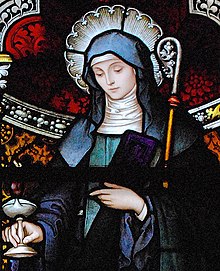
Back Halge Brigid ANG بريجيت كيلدير ARZ Santez Berc'hed Breton Brígida d'Irlanda Catalan Brigita Irská Czech Ffraid (santes) Welsh Brigida von Kildare German Brígida de Kildare Spanish Pyhä Brigid Finnish Brigitte d'Irlande French
Brigid | |
|---|---|
 Saint Brigid of Ireland in stained glass at St. Joseph Catholic Church in Macon, Georgia, U.S. | |
| Virgin | |
| Born | c. 451 Gaelic Ireland |
| Died | c. 525 Kildare, Kingdom of Leinster, Ireland |
| Venerated in | Catholic Church Anglican Communion Eastern Orthodox Church[1] |
| Feast | 1 February |
| Attributes | Brigid's cross; crozier of an abbess; flames or lamp; cow or geese[2] |
| Patronage | Kildare; Ireland; healers; poets; blacksmiths; livestock and dairy workers[2] |
Saint Brigid of Kildare or Saint Brigid of Ireland (Irish: Naomh Bríd; Classical Gaelic: Brighid; Latin: Brigida; c. 451 – 525) is the patroness saint (or 'mother saint') of Ireland, and one of its three national saints along with Patrick and Columba. According to medieval Irish hagiographies, she was an abbess who founded the important abbey of Kildare (Cill Dara),[3] as well as several other convents of nuns. There are few historical facts about her, and her hagiographies are mainly anecdotes and miracle tales, some of which are rooted in pagan folklore.[2] They say Brigid was the daughter of a chieftain and a slave woman, and was raised in a druid's household before becoming a consecrated virgin. She is patroness of many things, including poetry, learning, healing, protection, blacksmithing, livestock and dairy production. In her honour, a perpetual fire was kept burning at Kildare for centuries.
Some historians suggest that Brigid is a Christianisation of the Celtic goddess Brigid. The saint's feast day is 1 February, and traditionally it involves weaving Brigid's crosses and many other folk customs. It was originally a pre-Christian festival called Imbolc, marking the beginning of spring. From 2023 it is a public holiday in the Republic of Ireland.[4] This feast day is shared by Dar Lugdach, who tradition says was her student, close companion, and successor.
- ^ February 14 / February 1. https://www.holytrinityorthodox.com/htc/orthodox-calendar/
- ^ a b c Farmer, David. The Oxford Dictionary of Saints (Fifth Edition, Revised). Oxford University Press, 2011. pp.66–67, 467–470.
- ^ Jestice, Phyllis G. (2004). Holy People of the World: A Cross-Cultural Encyclopedia. ABC-CLIO. pp. 140–. ISBN 9781576073551. Retrieved 1 February 2013.
Brigid of Ireland, or of Kildare, has been venerated since the early Middle Ages, along with Patrick and Columba, as one of the three national Christian patron saints of Ireland. By the end of the seventh century, at least two Latin biographies had been written describing her as a nobleman's daughter who chose to consecrate her virginity to God, took the veil as a Christian nun, and became the leader of a community of religious women—or perhaps of both women and men. Certainly, by the 7th century, there was an important double monastery at Kildare that regarded her as its founder.
- ^ "St Brigid's Day: Ireland's new public holiday, the 1st named after a woman". 20 January 2022.
© MMXXIII Rich X Search. We shall prevail. All rights reserved. Rich X Search